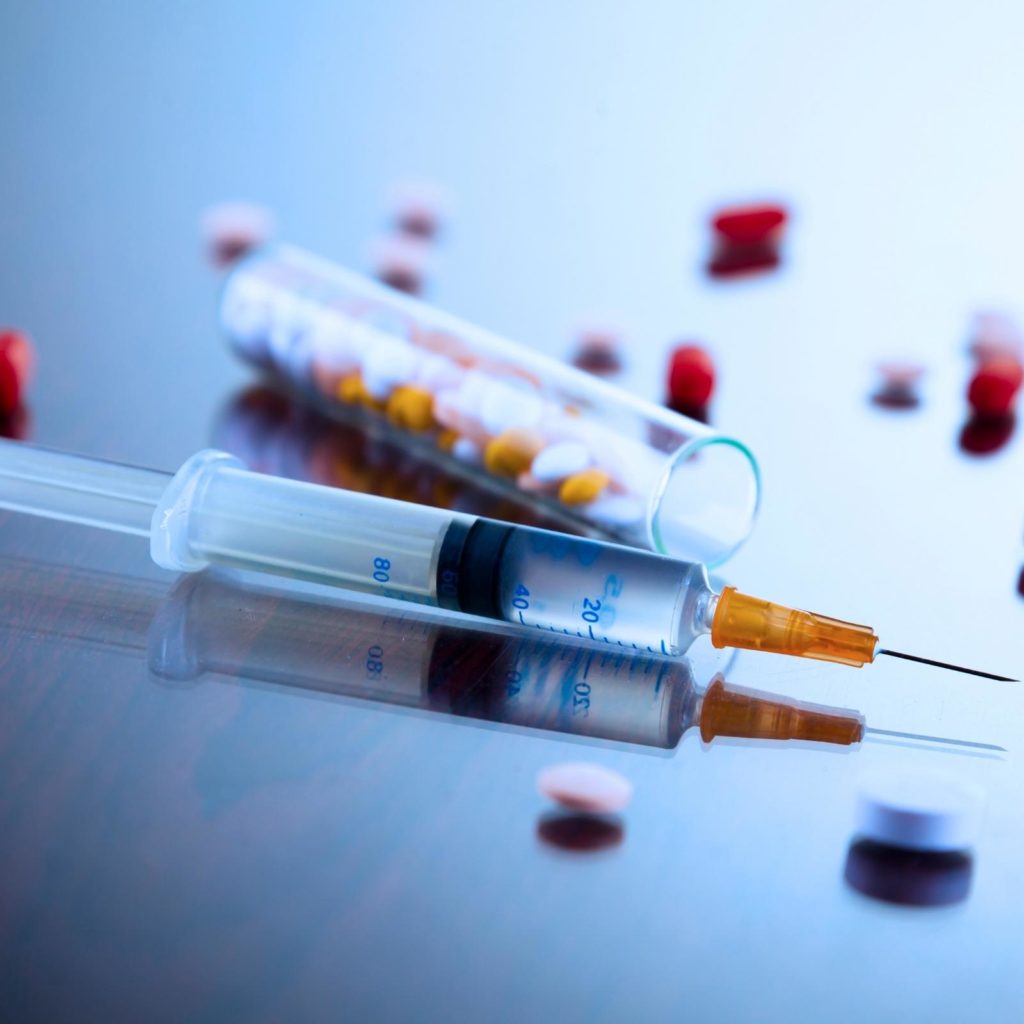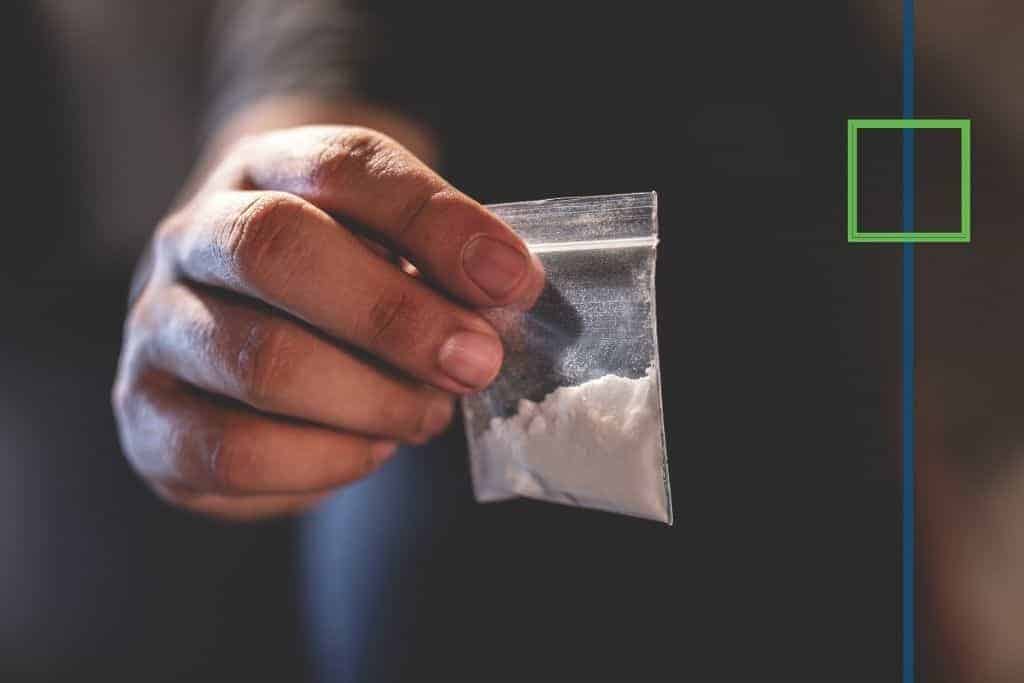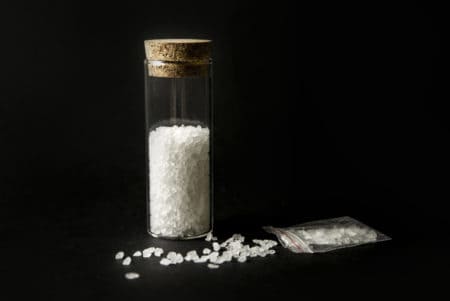What Is Fentanyl?
Pharmaceutical fentanyl is a synthetic opioid approved for treating severe pain, typically advanced cancer pain. It is 50 to 100 times more potent than morphine. It is prescribed in the form of fentanyl transdermal patches or lozenges and can be diverted for abuse. Most recent cases of fentanyl-related harm, overdose, and death in the U.S. are linked to illegally made and street fentanyl. It is sold through illegal drug markets for its effect similar to heroin. It is often mixed with heroin and/or cocaine as a “cutting agent” or combination product (speedball drug)—with or without the user’s knowledge—to increase its euphoric effects.
Pharmaceutical fentanyl is typically administered intravenously (IV), intramuscularly (IM), transdermally (TD) as skin patches, intranasally (IN) in the form of a volatile nasal spray, and intrathecally (IT). It is also available as a buccal soluble thin film, which can dissolve in the mouth, similar to the sublingual tablets. However, in contrast to other synthetic opioids, it is less common to find forms of synthetic drugs such as oral tablets or powders.


Get Your Life Back
Find Hope & Recovery. Get Safe Comfortable Detox, Addiction Rehab & Dual Diagnosis High-Quality Care.
Hotline(844) 597-1011Who is Most Likely to Abuse Fentanyl?
Fentanyl is addictive because of its potency. Moreover, taking certain medications with fentanyl may increase the risk that you will develop serious or life-threatening breathing problems, sedation, or coma. Overdose is one of the many effects of fentanyl abuse. According to the Center for Disease Control and Prevention (CDC) [1], rates of overdose deaths involving synthetic opioids other than methadone, which includes fentanyl and fentanyl analogs, increased by over 16% from 2018 to 2019. More than 36,000 people died from overdoses involving synthetic opioids in 2019. The latest provisional drug overdose death counts through May 2020 suggest an acceleration of overdose deaths during the COVID-19 pandemic.

Illicitly manufactured fentanyl (IMF) is available on the drug market in different forms, including liquid and powder. Powdered fentanyl looks just like many other drugs. It is commonly mixed with drugs like heroin, cocaine, and methamphetamine and made into pills that are made to resemble other prescription opioids. Fentanyl-laced drugs are extremely dangerous, and many people may be unaware that their drugs are laced with fentanyl. In its liquid form, IMF can be found in nasal sprays, eye drops, and dropped onto paper or small candies.
Fentanyl is abused because it produces a stronger high than other opioids. Because fentanyl is sold illegally in powder, liquid, spray, or pill., some substance abusers use fentanyl without knowing it because it is mixed into other drugs. This can include heroin, cocaine, methamphetamine, and MDMA. Very little of the drug is needed to produce the desired effects. People using other drugs may not realize fentanyl is laced into it. They may be taking a stronger dose that will lead to an overdose. What does fentanyl taste like? Because of this uncertainty, many people who abuse opioids now do “test doses” in hopes that they will be able to tell if the drug is laced with fentanyl.
How Do People Abuse Fentanyl?
Let’s understand who is most likely to abuse fentanyl. It’s not consumers. It’s drug smugglers and sellers who’ve found value in fentanyl. Because this drug is so much more powerful than heroin, a kilo of fentanyl contains many more doses than a kilo of heroin. That makes it more financially rewarding than even heroin. You just need a very small amount of fentanyl to make your heroin stronger. Nobody wants fentanyl in their heroin. In fact, it makes heroin use much more dangerous for the end-user, since the difference between a dose and an overdose of fentanyl is minuscule. It’s there because it makes selling and smuggling more profitable.
However, there are people who intentionally swallow, snort or inject fentanyl. They may also place blotter paper containing fentanyl in the mouth. The effects of fentanyl vary depending on the strength of the drug, the form of the drug, the method of use, and the person’s tolerance to opioids. Abusing fentanyl or taking high doses of the drug can cause vomiting, sweating, confusion, and slowed breathing. Other fentanyl abuse signs include trouble breathing, dizziness, low body temperature, and fainting.

Get Help. Get Better. Get Your Life Back.
Searching for Accredited Drug and Alcohol Rehab Centers Near You?
Even if you have failed previously and relapsed, or are in the middle of a difficult crisis, we stand ready to support you. Our trusted behavioral health specialists will not give up on you. When you feel ready or just want someone to speak to about therapy alternatives to change your life call us. Even if we cannot assist you, we will lead you to wherever you can get support. There is no obligation. Call our hotline today.
(844) 597-1011What factors can increase a person’s risk of becoming addicted to prescription fentanyl?
Like heroin, morphine, and other opioid drugs, fentanyl works by binding to the body’s opioid receptors, which are found in areas of the brain that control pain and emotions. After taking opioids many times, the brain adapts to the drug, diminishing its sensitivity, and making it hard to feel pleasure from anything besides the drug. When people become addicted, drug-seeking and drug use take over their lives.
Even just a couple of milligrams of this opioid can be fatal for recreational users. There are many illegal versions of it circulating in the streets, mixed with various substances that interact in dangerous ways. Called non-pharmaceutical fentanyl (NPF) or illicitly manufactured fentanyl (IMF), this drug is produced in makeshift labs and is often cut with cocaine or heroin.
Even with prescription use, fentanyl can cause respiratory failure, seizures, coma, and death. One of the major reasons Fentanyl deaths are rising is how quickly users die from it, well before most emergency medical personnel can administer successful treatment, often an injection of naloxone. In addition, the effect that fentanyl has on the muscles of the abdomen and chest often makes it difficult for first responders to administer CPR.
Fentanyl Abuse Signs & Symptoms
Fentanyl abuse and addiction may be similar to abuse and addiction of other opioid-related drugs. However, if a person has a prescription for fentanyl and they become addicted, they may frequently “lose” their prescription as a way to get more drugs. Doctor shopping may also be an issue with prescription fentanyl addiction. People who are addicted to prescription drugs may even steal family and friends’ prescriptions to get high. There are physical, emotional, and behavioral signs of addiction that people need to consider.
- Drowsiness, fatigue, or dozing off at inappropriate times
- Slurred speech and incoordination
- Swollen hands and feet
- Inability to fulfill responsibilities
- Moodiness
- Taking more of a prescription than intended to get the desired effect
- Money issues related to purchasing expensive street drugs
- Dizziness
- Constipation, nausea, and vomiting
- Withdrawal symptoms
- Intense cravings for the drug
- Continued use despite negative consequences
Fentanyl is also deadly if a person takes it not as prescribed. Signs of an overdose include confusion, blue-tinged lips and fingernails, unresponsiveness, coma, and death. It is imperative that witnesses call 911 if they believe someone is overdosing on fentanyl. If a person gets help from emergency responders quickly, medical professionals can reverse the effects of the drug and save a life.

Effects of Fentanyl Abuse
Long-term fentanyl abuse can cause effects on the entire body. From the brain, and other organs, to extensive tissue damage, including limb loss, the body as a whole is at risk when a person engages in long-term fentanyl abuse.
Long-term fentanyl use depresses the respiratory system. Respiratory depression over a long period of time can result in less oxygen being distributed throughout the body, which is referred to as hypoxia. This can cause overall, irreversible damage to tissue in the body and result in brain damage, and damage to the cardiovascular system, liver, digestive, and respiratory systems.
Long-Term Mental Health Effects Of Fentanyl Abuse
Fentanyl affects chemicals in the brain and can cause significant impairment to the mental health of those who abuse it. Whether fentanyl is linked to developing mental health issues or exacerbating existing issues, the following effects have been linked to long-term use:
- Increasing levels of depression
- Increased anxiety
- Lower ability to feel pleasure
- Inability to regulate emotion
- Higher risk of suicide
- Substance-induced Psychosis
- Impaired behavioral regulation
- Poor decision-making
In addition to these effects on mental health, fentanyl use has a unique effect on memory and cognition that has not been seen in other opioid abuse and addiction patients.
First-class Facilities & Amenities
World-class High-Quality Addiction & Mental Health Rehabilitation Treatment
Rehab Centers TourRenowned Addiction Centers. Serene Private Facilities. Inpatient rehab programs vary.
Addiction Helpline(844) 597-1011Proven recovery success experience, backed by a Team w/ History of:
15+
Years of Unified Experience
100s
5-Star Reviews Across Our Centers
10K
Recovery Success Stories Across Our Network
- Low Patient to Therapist Ratio
- Onsite Medical Detox Center
- Comprehensive Dual-Diagnosis Treatment
- Complimentary Family & Alumni Programs
- Coaching, Recovery & Personal Development Events
Fentanyl Abuse Side Effects
Fentanyl use may also increase the likelihood of a person engaging in risky behaviors over time. These behaviors may result in physical harm from fights, sexual trauma, or diseases associated with exposure to bodily fluids. In addition to the overall physical effects of fentanyl abuse, there are some unwanted side effects attributed to the method used to ingest fentanyl, like injecting, snorting, and smoking.
Long-Term Physical Side Effects Of Injecting Fentanyl
Injecting fentanyl increases the intensity of the drug and the quickness of onset, which is the appeal. However, it comes with an increased likelihood of additional long-term side effects, such as:
- HIV exposure (which can eventually lead to AIDS)
- Collapsed or damaged veins
- Seizures
- Liver cancer or cirrhosis
- Skin abscesses
- Stroke
- Significant weight loss
- Malnourishment
- Heart failure
- Sexual dysfunction
- Brain damage
- Coma
Long-Term Physical Side Effects Of Snorting Fentanyl
Snorting fentanyl is another method commonly used to abuse fentanyl. There are negative effects linked to this mode of ingestion, including:
- Increased thickened nasal drainage
- Severe nasal congestion
- Chronic bloody nose
- Problems swallowing
- Facial swelling (presumably due to infections in the nasal membranes)
- Perforations in the septum and/or palate
- Ulcers in mouth

Long-Term Physical Side Effects Of Smoking Fentanyl
Although a less common method of abuse, smoking fentanyl does have additional side effects associated with long-term use. This drug is not intended to be smoked, and the ingredients in the fentanyl are likely to cause many unwanted side effects, including:
- Lung damage
- Problems breathing
- Organ damage
- Oral problems (damage to teeth and gums, infections)
- System-wide toxicity (from chemicals and additives in fentanyl)
Fentanyl Abuse Methods
When prescribed by a doctor, fentanyl can be given as a shot, a patch that is put on a person’s skin, or as lozenges that are sucked like cough drops.
The illegally used fentanyl most often associated with recent overdoses is made in labs. This synthetic fentanyl is sold illegally as a powder, dropped onto blotter paper, put in eye droppers and nasal sprays, or made into pills that look like other prescription opioids.
Some drug dealers are mixing fentanyl with other drugs, such as heroin, cocaine, methamphetamine, and MDMA. This is because it takes very little to produce a high with fentanyl, making it a cheaper option. This is especially risky when people taking drugs don’t realize they might contain fentanyl as a cheap but dangerous additive. They might be taking stronger opioids than their bodies are used to and can be more likely to overdose.
World-class, Accredited, 5-Star Reviewed, Effective Addiction & Mental Health Programs. Complete Behavioral Health Inpatient Rehab, Detox plus Co-occuring Disorders Therapy.
CALL(844) 597-1011End the Addiction Pain. End the Emotional Rollercoaster. Get Your Life Back. Start Drug, Alcohol & Dual Diagnosis Mental Health Treatment Now. Get Free No-obligation Guidance by Substance Abuse Specialists Who Understand Addiction & Mental Health Recovery & Know How to Help.
Fentanyl Abuse Treatment
First and foremost, if you think that a loved one is abusing fentanyl, you should first research the drug and addiction associated with it so that you can better understand what your loved one needs. Next, you must plan an intervention to provide your loved ones with options to battle their fentanyl abuse signs in a safe and supportive environment. During this intervention, make sure that you offer compassion and support instead of judgment. Lastly, offer your support throughout the entire treatment process.
In addition, prolonged drug use can have severe physical and psychological effects on you, so it is essential to seek treatment as soon as possible. Inpatient drug rehab offers intensive care that can help you get through the early stages of withdrawal promptly.
Medically-Assisted Detox
Medical detox is often considered the first stage of treatment. It will help you navigate the complicated process of withdrawal, but it doesn’t address patterns of thought and behavior that contribute to drug use. Various treatment approaches and settings can help provide the ongoing support necessary to maintain long-term sobriety after you complete detox.
Cravings are very common during detox and can be challenging to overcome. This often leads to relapse. Constant medical care provided during inpatient treatment helps prevent relapse. Clinicians can provide necessary medication and medical expertise to lessen cravings and the effects of withdrawals.
Psychotherapy
Several different modalities of psychotherapy have been used in the treatment of mental health disorders along with addiction, including:
- Cognitive Behavioral Therapy (CBT) – is an effective treatment that involves making changes in both the patterns of negative thoughts and the behavioral routines which are affecting the daily life of the depressed person for various forms of depression.
- Dialectical Behavioral Therapy – is a comprehensive mental health and substance abuse treatment program whose ultimate goal is to aid patients in their efforts to build a life worth living. The main goal of DBT is to help a person develop what is referred to as a “clear mind.”
- Person-Centered Therapy – is a strategy that allows and encourages clients to understand and resolve their concerns in a safe, supportive environment.
- Solution Focused Therapy – is an approach interested in solutions that can be quickly implemented with a simple first step leading to further positive consequences.
Dual Diagnosis Treatment
Drug abuse and mental health disorders often co-occur. In many cases, traumatic experiences can result in a mental health disorder and substance abuse. Dual diagnosis rehabilitation treats both of these issues together. The best approach for the treatment of dual diagnosis is an integrated system. In this strategy, both the substance abuse problem and the mental disorder are treated simultaneously. Regardless of which diagnosis (mental health or substance abuse problem) came first, long-term recovery will depend largely on the treatment for both disorders done by the same team or provider.
Medication-Assisted Treatments
Medication-Assisted Treatments (MAT) for substance use disorders and mental health disorders are commonly used in conjunction with one another. This includes the use of medications and other medical procedures. During your rehab, the staff from your treatment facility will help you identify what caused your addiction and teach you skills that will help you change your behavior patterns and challenge the negative thoughts that led to your addiction. Sometimes, the pressures and problems in your life lead you to rely on substances to help you forget about them momentarily.
Please, do not try to detox on your own. The detox process can be painful and difficult without medical assistance. However, getting through the detox process is crucial for continued treatment. We Level Up provide proper care with round-the-clock medical staff to medically assist your recovery through our opioid addiction treatment program. So, reclaim your life, and call us to speak with one of our treatment specialists. Our counselors know what you are going through and will answer any of your questions.

Experience Transformative Recovery at We Level Up Treatment Centers.
See our authentic success stories. Get inspired. Get the help you deserve.
Start a New Life
Begin with a free call to an addiction & behavioral health treatment advisor. Learn more about our dual-diagnosis programs. The We Level Up Treatment Center Network delivers recovery programs that vary by each treatment facility. Call to learn more.
- Personalized Care
- Caring Accountable Staff
- World-class Amenities
- Licensed & Accredited
- Renowned w/ 100s 5-Star Reviews
We’ll Call You
Sources:
[1] CDC – https://emergency.cdc.gov/han/han00413.asp
[2] NIDA – https://nida.nih.gov/publications/drugfacts/fentanyl
[3] Fentanyl Addiction Treatment – We Level Up NJ


